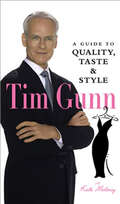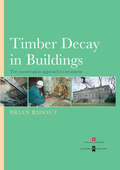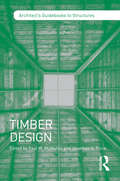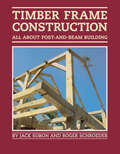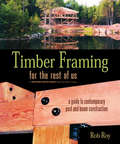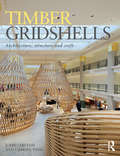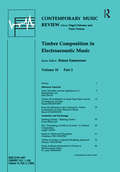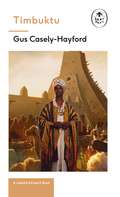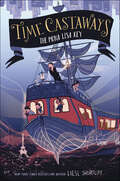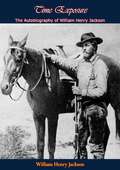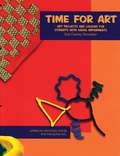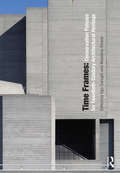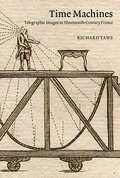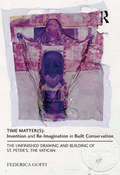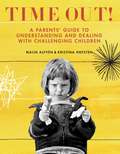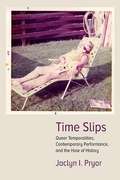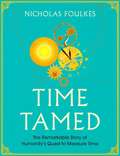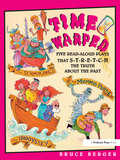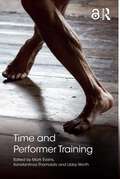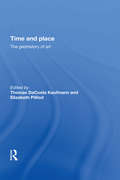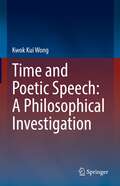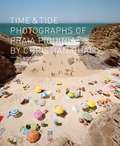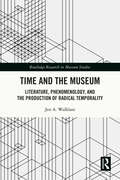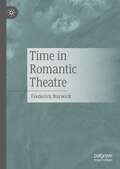- Table View
- List View
Tim Gunn: A Guide to Quality, Taste & Style
by Tim Gunn Kate Moloney“There seems to be no one more qualified or equipped to ponder or even, dare I say, dictate ‘quality, taste, and style’ than Tim.” —Sarah Jessica Parker, actor/producerAs Bravo’s style mentor on Project Runway and Chair of the Fashion Design Department at Parsons The New School for Design, Tim Gunn became a household name. He delivered advice in a frank, witty, and authoritative manner that delighted audiences. Now readers can benefit from Tim’s considerable fashion wisdom in Tim Gunn: A Guide to Quality, Taste & Style. He discusses every aspect of creating and maintaining your personal style: how to dress for various occasions, how to shop (from designer to chain to vintage stores), how to pick a fashion mentor, how to improve your posture, find the perfect fit, and more. He’ll challenge every reader—whether a seasoned fashionista or a style neophyte-to “make it work!”“Tim Gunn’s book is as fun and informative as his knowledge of fashion!!!” —Diane von Furstenberg, designer“Tim’s book is perfect for helping you find your own personal style and accentuate it. His witty and encouraging voice is evident throughout, focusing on everything from organizing your closet and maintaining your wardrobe to caring for your skin and perfecting your posture. Whether you’re a fashion expert or a style novice, Tim’s book is full of practical yet chic tidbits everyone can enjoy.” —Nina Garcia, editor-in-chief of Elle magazine“Whether revealing the secrets of ‘The Under Arsenal’ or ruminating on the ‘tone’ and ‘diction’ of a handbag, Gunn’s text is clever, a touch waggish, and highly practical for both ensemble mavens and fashion criminals.” —Publishers Weekly
Timber Decay in Buildings: The Conservation Approach to Treatment
by Brian RidoutThis is the first book to tackle all the issues relating to timber decay. It presents the facts and explores timber decay problems through case studies. These are illustrated with clear self-explanatory photographs for the reader to use as a diagnostic aid. Section 1 discusses timber as a living material, Section 2 deals with decay organisms and their habitat requirements. Section 3 moves on to the building as an environment for timber and discusses the ways in which wood responds to moisture change. Section 4 ends with an approach to timber decay which integrates knowledge on the decay organism, its requirements and natural predators with appropriate and targeted chemical treatments.
Timber Design (Architect's Guidebooks to Structures)
by Paul W. McMullin Jonathan S. PriceTimber Design covers timber fundamentals for students and professional architects and engineers, such as tension elements, flexural elements, shear and torsion, compression elements, connections, and lateral design. As part of the Architect’s Guidebooks to Structures series, it provides a comprehensive overview using both imperial and metric units of measurement. Timber Design begins with an intriguing case study and uses a range of examples and visual aids, including more than 200 figures, to illustrate key concepts. As a compact summary of fundamental ideas, it is ideal for anyone needing a quick guide to timber design.
Timber Frame Construction: All About Post-and-Beam Building
by Jack A. Sobon Roger SchroederDiscover the satisfaction of making your own durable, economical, and environmentally friendly timber frame structures. Covering all aspects of timber frame construction, this practical guide is filled with easy-to-understand instructions, clear illustrations, and helpful photographs. With expert advice on selecting appropriate timber, necessary tools, safety considerations, joinery techniques, assembly, and raising, Jack Sobon and Roger Schroeder encourage beginners by offering complete plans for a small toolshed. Turn your dream of a timber frame house into a reality.
Timber Framing for the Rest of Us
by Rob RoyMany natural building methods rely upon the use of post and beam frame structures that are then in-filled with straw, cob, cordwood, or more conventional wall materials. But traditional timber framing employs the use of finely crafted jointing and wooden pegs, requiring a high degree of craftsmanship and training, as well as much time and expense. However, there is another way . . .Timber Framing for the Rest of Us describes the timber framing methods used by most contractors, farmers and owner-builders--methods that use modern metal fasteners, special screws and common sense building principles to accomplish the same goal in much less time. And while there are many good books on traditional timber framing, this is the first to describe in depth these more common fastening methods. The book includes everything an owner-builder needs to know about building strong and beautiful structural frames from heavy timbers, including: the historical background of timber framing crucial design and structural considerations procuring timbers--including different woods and recycled materials foundations, roofs and in-filling considerations the common fastenersA detailed case study of a timber frame project from start to finish completes this practical and comprehensive guide, along with a useful appendix of span tables and a bibliography.Highly illustrated, this book enables "the rest of us" to build like the professionals and will appeal to owner-builders, contractors and architects alike.Rob Roy is a former contractor with 11 previous books to his credit. He has been utilizing timber framing techniques for the past 25 years in the construction of homes, as well as in the numerous outbuildings at Earthwood Building School which he founded in 1981 with his wife, Jaki. He is most recently the author of Cordwood Building: The State of the Art (New Society, 2003).
Timber Gridshells: Architecture, Structure and Craft
by John Chilton Gabriel TangThroughout history, people have constructed simple timber lattice shelters such as the tepee or yurt, covered with animal skins, leaves, grasses and woven fabrics. Over the last fifty years, more sophisticated ‘webs of wood’ have emerged, with timber gridshells in particular becoming a structurally expressive form of architecture. Recent developments in digital design, 3-D modelling software, timber fabrication technologies as well as trends towards low-carbon construction have further reinforced architects’ interest in the use of lightweight timber grids and lattice structures. This timely book charts the origin and evolution of the timber gridshell and its relation to timber lattice architecture. Drawing on a range of international case studies, the authors trace the effect advances in technology have had on design and construction in this field, providing a clear understanding of the structure, morphology, design process, and construction technology, and examining both the application and constraints of timber gridshells in architectural design. Timber Gridshells is a highly illustrated, up-to-date resource which provides detailed answers and inspires new ideas. As such, it is essential reading for students of architecture as well as professional architects.
Timbre Composition in Electroacoustic Music (Contemporary Music Review #10.2)
by Simon EmmersonFirst Published in 1994. The contributions to this collection have been selected to define a range of interests from the technical, aesthetic, cognitive and compositional spheres. The book addresses the continuing need for musicologists, psychologists, composers and listeners to enter into a creative dialogue with designers and builders, who are usually programmers in the contemporary world. The collection as a whole will help to demonstrate the great potential for exchange between the multidisciplinary approaches to music.
Timbuktu: The secrets of the fabled but lost African city (The Ladybird Expert Series #25)
by Gus Caseley-HayfordPart of the ALL-NEW Ladybird Expert series.Learn about Timbuktu, in this clear and authoritative introduction to the place considered to be one of the most important trading cities of the medieval world. Written by curator and cultural historian Gus Casely-Hayford, this book delves into the rise of the largest empire in West Africa and what made Timbuktu the most significant Saharan desert-port of the age. You'll encounter the Mali Empire in its golden age, teeming with riches, scholars and trades. Its history steeped in magicians, epic wars, story-tellers and missing ships. You'll learn what made Timbuktu so notorious and irresistible to Europe, and why centuries later it still enchants the Western World with its beauty, wealth, mystery, intellectual excellence and legacy.Inside you'll discover . . . - The significance of The River Niger - The great advantages of the introduction of camels- The birth of Mali- The connections between Islam and the Mali Empire- How the libraries give vivid access to the medieval African perspective- And much more . . . Written by the leading lights and most outstanding communicators in their fields, the Ladybird Expert books provide clear, accessible and authoritative introductions to subjects drawn from science, history and culture. For an adult readership, the Ladybird Expert series is produced in the same iconic small hardback format pioneered by the original Ladybirds. Each beautifully illustrated book features the first new illustrations produced in the original Ladybird style for nearly forty years.
Time Castaways: The Mona Lisa Key (Time Castaways #1)
by Liesl ShurtliffFrom Liesl Shurtliff, the New York Times bestselling author of Rump: The True Story of Rumpelstiltskin, comes a thrilling new middle grade trilogy about three city kids who get on the wrong subway train and wind up on a wild, magical mystery-adventure throughout time.Imaginative, daring, and packed with fun, Time Castaways is perfect for fans of Escape from Mr. Lemoncello’s Library and Percy Jackson.Mateo, Ruby, and Corey Hudson’s parents don’t have too many rules. It’s the usual stuff: Be good. Do your homework. And never ride the subway without an adult, EVER. But when the siblings wake up late for school, they have no choice but to break a rule. The Hudson siblings board the subway in Manhattan and end up on a frigate ship in Paris…in the year 1911.As time does tell, the Hudson family has a lot of secrets. The past, present, and future are intertwined—and a time-traveling ship called the Vermillion is at the center. Racing to untangle the truth, the kids find themselves in the middle of one of the greatest art heists of all time.And the adventure is just getting started.
Time Exposure: The Autobiography of William Henry Jackson
by William Henry JacksonThe unmatchable autobiography of the pre-eminent American photographer of the 19th century William Henry Jackson. Jackson, who was also a renowned painter, lived a long and adventure filled life from boyhood in New York through the Civil War, the Westward expansion, the Mexican-American War to the outbreak of WWII. This book is an exciting and captivating reading.
Time For Art: Art Projects and Lessons for Students with Visual Impairments
by Gail Cawley ShowalterThis simple manual gives some helpful suggestions for people who want to teach art to children who are blind or visually impaired. It also gives some suggestions on projects that the students can do. It is not intended as the "all around authority" on the topic but serves as a spring board into other projects and ideas. Topics and projects include, fake fossils, aluminum repousse, papier mache bowls, wire sculptures, and raised line drawings. Good book for anyone interested in ways to adapt lessons in art for learners with special needs. Also includes art projects which relate to science.
Time Frames: Conservation Policies for Twentieth-Century Architectural Heritage
by Ugo Carughi Massimo VisoneTime Frames provides a reconnaissance on the conservation rules and current protection policies of more than 100 countries, with particular attention to the emerging nations and twentieth-century architecture. The contributions illustrate the critical issues related to architectural listings, with a brief history of national approaches, a linkography and a short bibliography. The book also provides a short critical lexicography, with 12 papers written by scholars and experts including topics on identities, heritages, conservation, memories and the economy. By examining the methods used to designate building as heritage sites across the continents, this book provides a comprehensive overview of current protection policies of twentieth-century architecture as well as the role of architectural history.
Time Machines: Telegraphic Images in Nineteenth-Century France
by Richard TawsA riveting exploration of the relationship between art and telegraphy, and its implications for understanding time and history in nineteenth-century France.In Time Machines Richard Taws examines the relationship between art and telegraphy in the decades following the French Revolution. The optical telegraph was a novel form of visual communication developed in the 1790s that remained in use until the mid-1850s. This pre-electric telegraph, based on a semaphore code, irrevocably changed the media landscape of nineteenth-century France. Although now largely forgotten, in its day it covered vast distances and changed the way people thought about time. It also shaped, and was shaped by, a proliferating world of images. What happens, Taws asks, if we think about art telegraphically?Placed on prominent buildings across France—for several years there was one on top of the Louvre—the telegraph’s waving limbs were a ubiquitous sight, shifting how public space was experienced and represented. The system was depicted by a wide range of artists, who were variously amused, appalled, irritated, or seduced by the telegraph’s intractable coded messages and the uncanny environmental and perceptual disruption it caused. Clouds, architecture, landscapes, and gestures: all signified differently in the era of telegraphy, and the telegraph became a powerful means to comprehend France’s technological and political past. While Paris’s famous arcades began to crisscross the city at ground level, a more enigmatic network was operating above. Shifting attention from the streets to the skies, this book shows how modern France took shape quite literally under the telegraph’s sign.
Time Matter(s) (s) (s) (s): Invention and Re-Imagination in Built Conservation: The Unfinished Drawing and Building of St. Peter's, the Vatican
by Federica GoffiEven though the idea of altering an existing building is presently a well established practice within the context of adaptive reuse, when the building in question is a 'mnemonic building', of recognized heritage value, alterations are viewed with suspicion, even when change is a recognized necessity. This book fills in a blind spot in current architectural theory and practice, looking into a notion of conservation as a form of invention and imagination, offering the reader a counter-viewpoint to a predominant western understanding that preservation should be a 'still shot' from the past. Through a micro-historical study of a Renaissance concept of restoration, a theoretical framework to question the issue of conservation as a creative endeavor arises. It focuses on Tiberio Alfarano's 1571 ichnography of St. Peter's Basilica in the Vatican, into which a complex body of religious, political, architectural and cultural elements is woven. By merging past and present temple's plans, he created a track-drawing questioning the design pursued after Michelangelo’s death (1564), opening the gaze towards other possible future imaginings. This book uncovers how the drawing was acted on by Carlo Maderno (1556-1629), who literally used it as physical substratum to for new design proposals, completing the renewal of the temple in 1626. Proposing a hybrid architectural-conservation approach, this study shows how these two practices can be merged in contemporary renovation. By creating hybrid drawings, the retrospective and prospective gaze of built conservation forms a continuous and contiguous reality, where a pre-existent condition engages with future design rejoining multiple temporalities within continuity of identity. This study might provide a paradigmatic and timely model to retune contemporary architectural sensibility when dealing with the dilemma between design and preservation when transforming a building of recognized significance.
Time Out!: A Parents' Guide to Understanding and Dealing with Challenging Children
by Malin Alfvén Kristina Hofsten"I've failed as a parent," is a common statement of resignation when a child suddenly becomes awkward, defiant, angry, or generally impossible. What worked to calm them down a year ago might not necessarily work now and the parent blames herself for being too lenient or too strict.There's usually nothing developmentally wrong with an unruly child, but it can be a pain to deal with. Written by two child psychologists, outlines all of the developmental stages toddlers, children, and adolescents transition through, and how their behavior reflects that.With humorous anecdotes from real parents who have dealt with the same "crises" as most other parents, this guide offers hands-on-advice to deal with problems and also laugh a little.
Time Slips: Queer Temporalities, Contemporary Performance, and the Hole of History
by Jaclyn I. PryorPryor illuminates how each artist deploys performance as a tool to render history visible, trauma recognizable, and transformation possible by laying bare the histories and ongoing systems of violence woven deep into our society.
Time Tamed
by Nicholas FoulkesFor more than 25,000 years, mankind has sought to understand and measure the passing of time, in the process creating some of the most remarkable and beautiful timepieces. Now, in Nicholas Foulkes's lavishly illustrated book, the battle to tame time is brought vividly to life. From the baboon bone dating back to the palaeolithic era that marked the lunar cycle and on to the 3500-year-old water clock at Karnak, from our earliest days mankind has sought to track the passing of time. More recently, the struggles to measure longitude and to create a workable train timetable across the vast, open expanse of the United States have inspired new developments. In Time Tamed, Nicholas Foulkes reveals how we have done this by focusing on some of the most significant developments in timekeeping across the ages. He also highlights the most stunning and lavish clocks and watches in history - from Big Ben to Rolex - for telling the time has never been purely about function, but also about design. The book is filled with remarkable tales, from the 14th century monk in St Albans who created one of the first mechanical clocks to the Holy Roman Emperor who built a clock into an automated ship that fired a cannon to summon guests to dinner. More recently, there was the Surrey woman who used a Napoleonic era watch to 'deliver' the accurate time to London shopkeepers in the wartime era of Churchill, or the Swiss denture maker who solved a tricky problem for the Indian Raj's polo players. Time Tamed is a book you'll want to spend many hours enjoying.
Time Warped
by Bruce BergerTime Warped is a book of five read-aloud plays that stretch the truth about the past. With plays such as “Renaissance Reform School” and “The Idiodyssey,” this book will have students laughing as they try to decipher what is real and what is not.Each play includes follow-up activities for writing, discussion, and research.
Time and Performer Training
by Mark Evans Libby Worth Konstantinos ThomaidisTime and Performer Training addresses the importance and centrality of time and temporality to the practices, processes and conceptual thinking of performer training. Notions of time are embedded in almost every aspect of performer training, and so contributors to this book look at: age/aging and children in the training context how training impacts over a lifetime the duration of training and the impact of training regimes over time concepts of timing and the ‘right’ time how time is viewed from a range of international training perspectives collectives, ensembles and fashions in training, their decay or endurance. Through focusing on time and the temporal in performer training, this book offers innovative ways of integrating research into studio practices. It also steps out beyond the more traditional places of training to open up time in relation to contested training practices that take place online, in festival spaces and in folk or amateur practices. Ideal for both instructors and students, each section of this well-illustrated book follows a thematic structure and includes full-length chapters alongside shorter provocations. Featuring contributions from an international range of authors who draw on their backgrounds as artists, scholars and teachers, Time and Performer Training is a major step in our understanding of how time affects the preparation for performance.
Time and Place: The Geohistory of Art
Authors from Herodotus in antiquity to Vasari in the Renaissance related art and architecture to peoples, nations, regions, cities, and environments. Already with Winckelmann and the origins of discussion of art history in the eighteenth century geography was seen as a powerful determinant of art. In the nineteenth century, the perceived connection between nations or races and art flourished, mainly because of the rise of nationalism. Around 1900 the method of geographical analysis received a modern name, 'Kunstgeographie'. But the ideology of 'Blut and Boden' associated with Nazism and related ideologies brought the geography of art into disrepute. This book proposes to return anew to the approach of artistic geography, which had been largely neglected from the Second World War until recently, and to reevaluate the possibilities it provides through a selection of case studies that discuss the connection between art and its place. The introduction and first essay deal with the historiography of the geography of art. Five essays take up specific questions ranging from France and the Low Countries to Mexico and China. The final three essays consider contemporary and broader theoretical issues concerning art in time and place.
Time and Poetic Speech: A Philosophical Investigation
by Kwok Kui WongThis book analyzes the relation between the flow time and poetic speech in drama and rhetoric. It begins with the classical understanding of time as flux, and its problems and paradoxes entailing from Aristotle, Augustine, Kant and Husserl. The reader will see how these problems unfold and find resolutions through dramatic speech and rhetoric which has an essential relation to the flow of time. It covers elements in poetic speech such as affect, rhythm, metaphor, and syntax. It uses examples from classical rhetorical theories by Aristotle, Cicero, Quintilian, dramatic speeches from Shakespeare, as well as other modern dramatic texts by Chekhov, Beckett, Jelinek and Sarah Kane. This book appeals to students and academic researchers working in the philosophical fields of aesthetics and phenomenology as well those working in theater and the performing arts.
Time and Tide
by Jen Bekman Christian ChaizeFeaturing colorful beach umbrellas and dreamy blue horizons, this beautiful oversized book offers a breath of fresh air and evokes fantasies of Mediterranean travel. Photographer Christian Chaize returned many times over the course of eight years to shoot an intimate beach in the south of Portugal from the same vantage point. The resulting photographs provide an enchanting portrait of the tides, light, weather, and people that shape and reshape the landscape each day. A charming and thought-provoking meditation, Time and Tide will appeal to anyone who loves the beach or appreciates the miracle of close looking inherent in photography.
Time and the Museum: Literature, Phenomenology, and the Production of Radical Temporality (Routledge Research in Museum Studies)
by Jen A. WalklateTime and the Museum: Literature, Phenomenology, and the Production of Radical Temporality, is the first explicit in-depth study of the nature of museum temporality. It argues as its departure point that the way in which museums have hitherto been understood as temporal in the scholarship - as spaces of death, othering, memory and history - is too simplistic, and has resulted in museum temporality being reduced to a strange heterotopia (Foucault) - something peculiar, and thus black boxed. However, to understand the ways in which museum temporalities and timescapes are produced, and the consequences that these have upon display and visitor response, is crucial, because time is itself a political entity, with ethical consequence. Time and the Museum highlights something we all experience in some way - time - as a key ethical and political feature of the museum space. Utilizing the fields of literature and phenomenology, the book examines how time is experienced and performed in the public areas of three museum spaces within Oxford - the Ashmolean, Pitt Rivers, and Oxford University Museum of Natural History. Using concepts such as shape, structure, form, presence, absence, authenticity and aura, the book argues for a reconsideration of museum time as something with radical potential and political weight. It will appeal to academics and postgraduate students, especially those engaged in the study of museums, culture, literature and design.
Time for Magic: A Shamanarchist's Guide to the Wheel of the Year
by Philip Carr-Gomm John Marchant Jamie Reid Stephen EllcockPunk meets Druidry in the only trade edition of Jamie Reid's art, weaving c.180 radical art images into the structure of the pagan Wheel of the Year. The art is selected and introduced by curator Stephen Ellcock with notes on the seasonal celebrations by former Chief Druid of OBOD Philip Carr-Gomm.Time for Magic offers an entrancing overview of Jamie Reid&’s incredible art, structured around the eight seasonal festivals of the Wheel of the Year (the equinoxes and solstices plus Imbolc, Beltane, Lughnasadh and Samhain). Jamie observed these festivals, holding rituals at his allotment in Liverpool, and focused on this theme in his later paintings. This book features key Wheel of the Year artworks as well as famous earlier pieces, including the pre-punk, Situationist-inspired agit-prop and the work he produced for the Sex Pistols. Curator Stephen Ellcock has selected the art and in his own inimitable creative style arranged it into season-themed chapters, as well as finding images of Druidic ceremonies held by Jamie&’s great-uncle, Chief Druid George Watson MacGregor Reid.Stephen Ellcock in conversation with John Marchant introduces Jamie&’s life, legacy and love of making trouble; John Marchant provides captions giving deep insight in Jamie&’s work; and Philip Carr-Gomm writes about the Wheel of the Year and how it can help us find a new way of being in this era of climate crisis.
Time in Romantic Theatre
by Frederick BurwickThe shift in temporal modalities of Romantic Theatre was the consequence of internal as well as external developments: internally, the playwright was liberated from the old imperative of “Unity of Time” and the expectation that the events of the play must not exceed the hours of a single day; externally, the new social and cultural conformance to the time-keeping schedules of labour and business that had become more urgent with the industrial revolution. In reviewing the theatre of the Romantic era, this monograph draws attention to the ways in which theatre reflected the pervasive impact of increased temporal urgency in social and cultural behaviour. The contribution this book makes to the study of drama in the early nineteenth century is a renewed emphasis on time as a prominent element in Romantic dramaturgy, and a reappraisal of the extensive experimentation on how time functioned.
